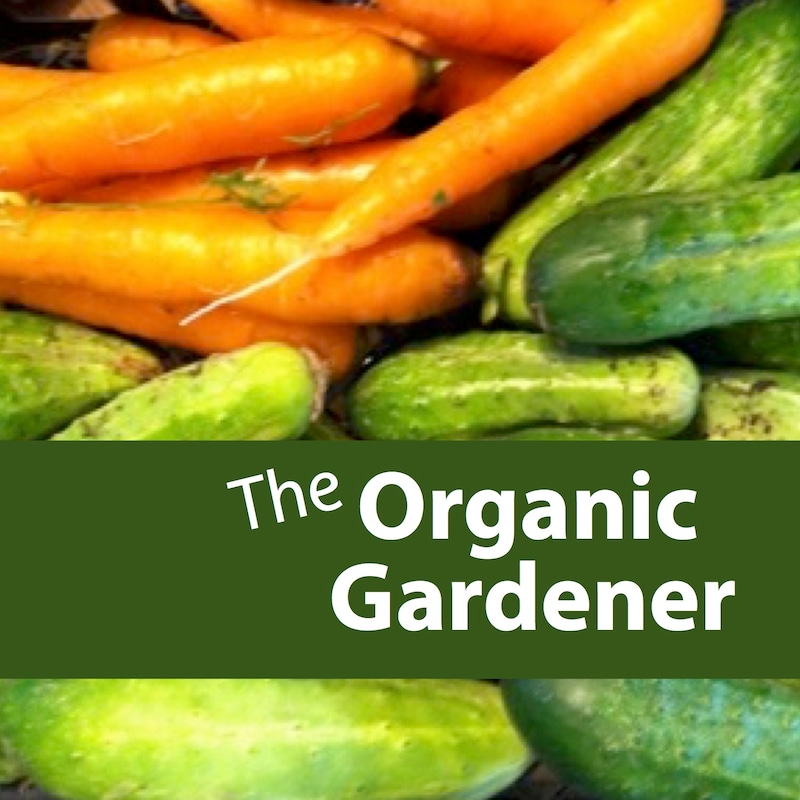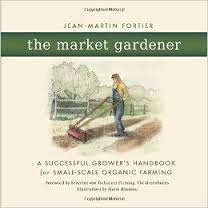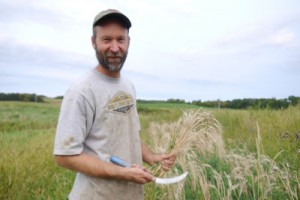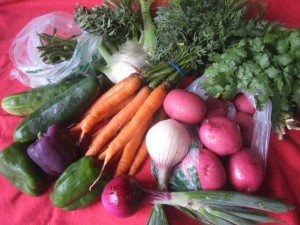
Shownotes
Welcome Gardeners to the show today! I’m super excited to introduce my guest owner of the Lida Farm in Pelican Rapids Minnesota just an hour east of Fargo, North Dakota where Good Food is Grown Well. Raising a family while growing a variety of produce in this challenging climate will inspire every gardener that choosing to eat well is an option while we learn some great secrets and tips.
Tell us a little about yourself.
Where to start? My wife Maree, and I own and operate Lida Farm, we’re both in our 30s, we’ve been doing our current location for 12 years. I got into organic commercial production a few years before that. We have got 3 kids oldest is 10 Sylvia, Willem is 8, and Graham, our youngest is 5. That’s the whole work crew and family at Lida Farm.
Although we do have an Apprentice Kelsey Wolf who has lived with us here the past couple of summers and is probably gonna sign up again!
We live on a 20 acre farmstead, here in Minnesota’s’ lake district, the west central lakes district, the land of 10 thousand lakes. This year we have 3 and 1/2 acres of produce, it’s an integrated farm operation, we have a few hundred broilers this year, we raised 7 hogs we have a milk cow, cow calf pair on back pasture. That’s kind of the operation. I also have a day job, always a surprise to some people. I work full time for University of Minnesota extension. A lot of time people think I must do horticulture but I do community development and business community. I do a lot of spreadsheets, market analysis and stuff. That’s sort of a thumbnail sketch of my life.
Wow! That’s a lot, plus raising a family!
It’s a lot to run. basically run
these all these crazy things people do to make a mortgage each month, so I can’t really give up one or the other at this point.
I guess you have to do what you gotta do. I’m surprised at some of the things I’ve done here in Montana.
Tell me about your first gardening experience?
I’m originally from East Grand Forks, which is in Minnesota, on the border with North Dakota. Some people might be familiar with the Red River Valley, it’s a great big flat and North Dakota and South Dakota where a lot of sugar beets and potatoes have been grown.
My first gardening experience, East Grand Forks is a blue collar company town
in the shadow of sugar beet factory lagoon and a potato processing plant potato ex
family plot, did the really standard things everybody’s family grows. next to my uncle
sugar beet factory
lagoon
family plot standard things everybody.
Small thing like anyone is doing in their backyard. Maybe 30×40 feet… it was kind of an abandoned industrial area, and abandoned piece of ground, a bunch of weeds growing up. What a lot of people are doing today, in urban gardening taking an abandoned lot and making community gardens out of them.
Kind of like squatting in an gardening sense.
What does organic gardening/earth friendly mean to you?
For me, when thinking about it, I always think about some kind of farming that cares for creation that we have been entrusted with. One, to me I think the best of organic farming,Ill speak in terms of farming instead of gardening, because that’s more my scale if you will, something that brings more people on the land, a lot of something is celebrated on your farm, bringing community together. I think a lot of people are divorced from the land, everyone lives by a strip mall, it seems. There’s a hunger intrinsically in people’s hearts for a reconnection operate. We operate a CSA. At our end of season harvest party, we brought a lot of people to our farm and the people touch the earth saw the animals in pasture, ate with each other, music, the community that can build around a local organic farm. I think that is the best that organic framing can bring in large part, when you think about it kind of part of conventional ag has been how do we get as few people on the ground as possible. How can one person grow as much as possible? That’s where ag has been, and that’s where it continues to go. I was a neighbors and he got these 2 robotic milkers, hundreds of animals going through the
opposite of where a lot of organic farms are going. more people engaged in farming.
Some people might say we are really inefficient, but I think of it as reconnecting people.
families out working the ground together, community
Seems like you must be efficiently to be doing all of this and raising all this food, and producing for a CSA and have all these people come. Just seeing what my husband did last year and what it took do produce what we did and think about what it would take to run a CSA maybe we just need to learn some efficient techniques.
Who or what inspired you to start using organic techniques?
Kind what got me into the whole local food movement in general, I studied at Gustavus Adolphus College a Swedish college in Minnesota no surprise? Right in the southern part of the state. I was like any idealistic late teenager, involved in the environmental movement, involved in college politics. For me, it’s like everyone wants to make a stamp or change in the world. What got me in the local food movement, in the same town there was a food compl, the St. Peter food coop, been there since the 70s small coop local farmers, semi-reformed hippies, turned onto the scene, doing environmental work with your 2 hands, connecting with local farmers, directly supporting those local farers who are in turn doing good practices on the land. Seemed much more of a straight line of change on the landscaped. Instead of other people try though policy change which is like a black hole. I can get involved though this vehicle. Led me to organic farming which led me to doing an apprenticeship.
Did I see you did it at Foxtail Farm?
I worked there for Foxtail Farm, they’re one of the first CSA’s in and around the twin cities in 1999-2000-2001
how far, at that time there were maybe a dozen CSA’s in Minnesota.
committed to CSA members, in their 3rd year at the time. Now in a point of comparison. I think Minnesota has probably 130 CSA operations.
Im just gonna break in and explain CSA stands for Community Supported Agriculture. Do you want to explain what that means?
Some people say it’s a subscription model. people are paying up front a share of the seasons’ harvest or vegetables each week. It’s since then applied to other products. Most people think of vegetables, but there are now meat CSA flower cut flower operators and non-ag products a non profit down the road, with community supported art, where you get a different piece of art each month.
A few people have told me I should get onto this thing called Patreon that’s like that for musicians and artists. Where you can get like a new song each month or a drawing or painting or something that people get a digital copy of. Kind of like Kickstarter or something?
How did you learn how to garden organically?
On the commercial side of horticulture, you learn a lot by being hands on for a couple of seasons, It’s hard to imagine, I’ve got this 20 x 30 plot, how do you scale this up to 2 acres. At that time at Foxtail we were doing 15-16 acres. What does that even look like? It’ helps to see, how to scale equipment, learn how to do things quickly or efficiently to produce a good looking box each week?
My husband made some good looking boxes, but I thought here’s one or 2 boxes, but how are we ever gonna make 50-100 of these?
How did you find your apprentice? Through the WWOOFing program or Todd Ulizio talked about using ATTRA in episode 3.
Land Stewardship Project very active organization, that supports organic growers and sustainable ag types hosted a lot of internships on sustainable ag farms.
That’s how I found them, I went to 3-4 different farms over a week, and Foxtail seemed like the best match. I want to get into this organic farming, find where you’re most comfortable and there is a good fit.
you hear about internships and apprenticeships that go bad, somebody lasts only 6 weeks on a farm, and then they disappear, some is personality mismatch which happens on any day.
you just got to find one that works well
Willing workers on organic farms. WWOOFers. Some use it as a way of seeing the world as well. Australia usually those are short term stints as compared to long term stints.
I had some guests on Neke and Jeremy who went down to Argentina and other places.
advantage of woofing it. The disadvantage you don’t really see the full cycle.
If you’re really serious about getting into it, there’s a lot to be said of a whole season from seeds being planted before the final wrap up when the snow’s gonna fly.
It kind of helps you learn about different places,
where’s the sun in June, compared to where’s the sun in September, when you spend a whole season in one place there’s a great benefit. Having all those experiences can only help people.
Tell us about something that grew well this year.
The thing that grew really well this year, was our pepper crop, I was suspicious that it would go anywhere, this year was the first year we had a bit of an aphid issue in our greenhouse, when I put these things out, they were looking
see a crop have some aphid issues, it usually has these lower leaves that are turning yellow. not falling over dead, but a stressed plant, aphids are taking little bites of nutrition. They looked bad, but what ended up happening here in Minnesota, we had the miracle growing year,
We had some wonderful timely rains, all the way through the early part of August.
we’re getting rain, rainy season that is gonna go typically April, May, a little bit into June, you get iffy rain through June and July we had some wonderful rain that happened into early august
got plants established, didn’t do any irrigation really, then we had a lot of heat, a good long growing season. That really did well for peppers. I didn’t know what to do with them.
We had about 2300 pepper plants!
once you start getting and a really good bumper crop!
what do you do?
At the market we were selling off half and full bushels for people to freeze and hold somethings over. Members were asked to come out and pick pepper to freeze to have over the winter.
we did a bunch of that ourselves but there’s only so much you can do.
You said you’ve been doing this for 10 years? How do you decide how many peppers to plant?
12 years here,
1 year,
2 years at Foxtail
I’t about my 15th season
To figure out the scale issue, get’s to be a little tough. One way I kind of think about it, I had the experience of 2 years on the same farm. What you end up getting a sense of the proportion of different crops. Winter squash takes a lot more room, sweet corn. So you got a sense of if you had a one acre field.
what proportion of different crops. How to get a good mix. That’s what we’re trying to do with the CSA because if you don’t have the mix it doesn’t work so we’ll
what’s happened over time
first year we were doing farmers
1/3 of an acre
but I had a sense of those proportions. So maybe 30% was dedicated to pumpkins and winter squash and another 15% sweet corn on down the line. So as we’ve grown from 1/3 of an acre to 3 1/2 acre the proportions are pretty much the same you just keep adding more.
It’s hard to say I have x number of shares I have to fill, I need x number of plants
some people will do that and there are even calculators online. Johnny’s has a nice calculator. I you google CSA calculator you can get some that are helpful with crop planting. But I’ve just been winging it.
I have spreadsheets galore in terms of financial analysis, was the farm profitable. But an actual crop planning, getting that figured out? No, I don’t do it at all.
What happens you say, last year I was pretty long on peppers, maybe I should do 1800 instead of 2300, or last year we were a little bit short on cauliflower. we did about 3 flats, for spring planting, we should bump that up to about 4 flats.
after you’ve done it for years, you’re looking at what I did last year, and then you’re projecting forward. Even on a commercial scale. Some are more planned out and there are a lot like me.
Is there something you would do different next year or want to try/new?
One book I picked up this year that I have been really interested in. A lot of us in commercial horticulture have been devotes of Eliot Coleman is the standard. A lot of people know his new organic grower, The Four Season Harvest.
T he guy that wrote a book last year Jean-Martin Fortier. He wrote a book called Market Gardener: A Successful Grower’s Handbook for Small Scale Organic Farming essential for an acre and a half…on his market farm in Quebec. He has some interesting techniques, one I did a little bit of this year, but I want to do more of next year. He’s using tarps as a solar
he guy that wrote a book last year Jean-Martin Fortier. He wrote a book called Market Gardener: A Successful Grower’s Handbook for Small Scale Organic Farming essential for an acre and a half…on his market farm in Quebec. He has some interesting techniques, one I did a little bit of this year, but I want to do more of next year. He’s using tarps as a solar
he uses it quite extensively
taking a large tarp putting it over a space in terms of reading it for planting it at a later date
retaining a lot of moisture like mulch but at the same time it’s warming up.
warming up
seeds are germinating under the, because there is no light they are also dying under the tarp
put it over a given area. A lot of people have done this
you have this nice really friable, you see a lot of earthworms,
having a nice clean slate
French Term in Europe on organic vegetation. it’s called
acqualeration, so that’s the technique
next year
using woven black fabric, we did that with
landscape
with our garlic beds some areas in one front field
using aqualtation. That’ landscape fabric.
sandbags on either sides of that
made garlic planting just beautiful
something we’re gonna have a little more of.
Joyce Pinson talked about that book. My husband did some of that. We planted a mini-farm, it was total forest land as much as sod, and he put that black plastic down where he planted his wheat, but he saw this other thing about building a reservoir in there. Joyce was excited about implementing some of his techniques too.
I think it’s a good resource for people who are looking to start out
I think if you are looking to do a little
we learend a lot from that book. I want to say, I read it in the spring, his main crops is microgreens and he sells them to restaurants
he does a lot of greenhouse tomatoes.
Tell me about something that didn’t work so well this season.
Kind of a banner year, something that’s problematic.
Failed on this year two. Fall brassicas well. Generally they do better. We typically have a really short spring. Makes it difficult to get them in early enough, if you put them in too early all they do is freeze! In the spring typically a lot of broccoli, get’s stressed out it just doesn’t do that well
if you time it out right it does beautiful.
days are getting shorter bolting is just not an issue,
days are getting longer things want to bolt
Think of all these fall greens! I always seem to fail, when should I get those fall brassicas in? Here again I took a new variety of cauliflower was just 12-10 days later then the other one and it made all the difference! I planted it,
it’s easy,
you can get a week off, you missed
That was the big thing I learned was that I thought fall planting would start planting in the fall, but you’re actually starting the seeds indoors around the end of June, July before summer even starts. When are you putting the plants out the middle of August, September?
we had planted that cauliflower 3rd week of July, and that was too late!
OK, so you started by seed and put seeds in the ground in July? or put plants out?
No we put plants out!
We start everything by seed.
When do you start the seeds.
I think we start the seeds I think we started the end of June and then July
this was a longer season cauliflower Skywalker if I had done Snow Crown which is a shorter season I would have been fine.
there are some calculators on finding fall planting dates,
essentially you have to add at least 14 days! And of course depending on when you are planting it it gets exaggerated for any crop!
If it’s a shorter season thing that you are planting longer. You’re typically not thinking about fall crops in June, you’re barely getting summer crops settled. You don’t want to think about fall crops because you’re just thinking of summer but you have to.
My other big lesson was pay attention to variety. One thing I hope people are learning that you said is you might have some challenges in the beginning most of what you grow is going...




